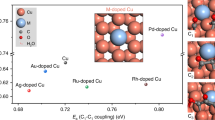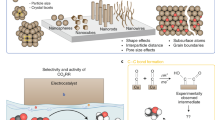Abstract
Using renewable electricity to convert CO/CO2 into liquid products is touted as a sustainable process to produce fuels and chemicals, yet requires further advances in electrocatalyst understanding, development and device integration. The roughness factor of an electrode has generally been used to increase total rates of production, although rarely as a means to improve selectivity. Here we demonstrate that increasing the roughness factor of Cu electrodes is an effective design principle to direct the selectivity of CO reduction towards multicarbon oxygenates at low overpotentials and concurrently suppressing hydrocarbon and hydrogen production. The nanostructured Cu electrodes are capable of achieving almost full selectivity towards multicarbon oxygenates at an electrode potential of only –0.23 V versus the reversible hydrogen electrode. The successful implementation of this catalytic system has enabled an excellent CO reduction performance and elucidated viable pathways to improve the energy efficiency towards liquid fuels in high-power conversion electrolysers.
This is a preview of subscription content, access via your institution
Access options
Access Nature and 54 other Nature Portfolio journals
Get Nature+, our best-value online-access subscription
$29.99 / 30 days
cancel any time
Subscribe to this journal
Receive 12 digital issues and online access to articles
$119.00 per year
only $9.92 per issue
Buy this article
- Purchase on Springer Link
- Instant access to full article PDF
Prices may be subject to local taxes which are calculated during checkout





Similar content being viewed by others
Data availability
The data that support the results and other findings of this study are available from the corresponding authors upon reasonable request.
References
Costentin, C., Robert, M. & Saveant, J.-M. Catalysis of the electrochemical reduction of carbon dioxide. Chem. Soc. Rev. 42, 2423–2436 (2013).
Gattrell, M., Gupta, N. & Co, A. Electrochemical reduction of CO2 to hydrocarbons to store renewable electrical energy and upgrade biogas. Energy Convers. Manag. 48, 1255–1265 (2007).
Gattrell, M., Gupta, N. & Co, A. A review of the aqueous electrochemical reduction of CO2 to hydrocarbons at copper. J. Electroanal. Chem. 594, 1–19 (2006).
Hori, Y. in Modern Aspects of Electrochemistry (eds Vayenas, C. G., White, RE & Gamboa-Aldeco, M. E.) 89–189 (Springer, 2008).
Hori, Y., Kikuchi, K. & Suzuki, S. Production of CO and CH4 in electrochemical reduction of CO2 at metal electrodes in aqueous hydrogencarbonate solution. Chem. Lett. 14, 1695–1698 (1985).
Peterson, A. A., Abild-Pedersen, F., Studt, F., Rossmeisl, J. & Norskov, J. K. How copper catalyzes the electroreduction of carbon dioxide into hydrocarbon fuels. Energy Environ. Sci. 3, 1311–1315 (2010).
Kortlever, R., Shen, J., Schouten, K. J. P., Calle-Vallejo, F. & Koper, M. T. M. Catalysts and reaction pathways for the electrochemical reduction of carbon dioxide. J. Phys. Chem. Lett. 6, 4073–4082 (2015).
Kuhl, K. P., Cave, E. R., Abram, D. N. & Jaramillo, T. F. New insights into the electrochemical reduction of carbon dioxide on metallic copper surfaces. Energy Environ. Sci. 5, 7050–7059 (2012).
Torelli, D. A. et al. Nickel–gallium-catalyzed electrochemical reduction of CO2 to highly reduced products at low overpotentials. ACS Catal. 6, 2100–2104 (2016).
Hahn, C. et al. Synthesis of thin film AuPd alloys and their investigation for electrocatalytic CO2 reduction. J. Mater. Chem. A 3, 20185–20194 (2015).
Kuhl, K. P. et al. Electrocatalytic conversion of carbon dioxide to methane and methanol on transition metal surfaces. J. Am. Chem. Soc. 136, 14107–14113 (2014).
Schouten, K. J. P., Kwon, Y., van der Ham, C. J. M., Qin, Z. & Koper, M. T. M. A new mechanism for the selectivity to C1 and C2 species in the electrochemical reduction of carbon dioxide on copper electrodes. Chem. Sci. 2, 1902–1909 (2011).
Liu, X. et al. Understanding trends in electrochemical carbon dioxide reduction rates. Nat. Commun. 8, 15438–15444 (2017).
Mittal, C., Hadsbjerg, C. & Blennow, P. Small-scale CO from CO2 using electrolysis. Chem. Eng. World 00, 44–46 (2017).
Haas, T., Krause, R., Weber, R., Demler, M. & Schmid, G. Technical photosynthesis involving CO2 electrolysis and fermentation. Nat. Catal. 1, 32–39 (2018).
Roberts, F. S., Kuhl, K. P. & Nilsson, A. Electroreduction of carbon monoxide over a copper nanocube catalyst: surface structure and pH dependence on selectivity. ChemCatChem 8, 1119–1124 (2016).
Kim, Y.-G. et al. Surface reconstruction of pure-Cu single-crystal electrodes under CO-reduction potentials in alkaline solutions: a study by seriatim ECSTM-DEMS. J. Electroanal. Chem. 780, 290–295 (2016).
Calle-Vallejo, F. & Koper, M. T. M. Theoretical considerations on the electroreduction of CO to C2 species on Cu(100) electrodes. Angew. Chem. Int. Ed. 52, 7282–7285 (2013).
Hori, Y., Takahashi, R., Yoshinami, Y. & Murata, A. Electrochemical reduction of CO at a copper electrode. J. Phys. Chem. B 101, 7075–7081 (1997).
Li, C. W., Ciston, J. & Kanan, M. W. Electroreduction of carbon monoxide to liquid fuel on oxide-derived nanocrystalline copper. Nature 508, 504–507 (2014).
Raciti, D. et al. Low-overpotential electroreduction of carbon monoxide using copper nanowires. ACS Catal. 7, 4467–4472 (2017).
Wang, L. et al. Electrochemical carbon monoxide reduction on polycrystalline copper: establishing selectivity trends for multi-carbon and oxygenate products as function of potential, pressure and pH. ACS Catal. 8, 7445–7454 (2018).
Ren, D., Fong, J. & Yeo, B. S. The effects of currents and potentials on the selectivities of copper toward carbon dioxide electroreduction. Nat. Commun. 9, 925 (2018).
He, D., Wan, J., Suo, H. & Zhao, C. In situ facile surface oxidation method prepared ball of yarn-like copper oxide hierarchical microstructures on copper foam for high performance supercapacitor. Mater. Lett. 185, 165–168 (2016).
Xu, X., Yang, H. & Liu, Y. Self-assembled structures of CuO primary crystals synthesized from Cu(CH3COO)2–NaOH aqueous systems. CrystEngComm 14, 5289–5298 (2012).
Zhang, W., Wen, X., Yang, S., Berta, Y. & Wang, Z. L. Single-crystalline scroll-type nanotube arrays of copper hydroxide synthesized at room temperature. Adv. Mater. 15, 822–825 (2003).
Zhang, W., Wen, X. & Yang, S. Controlled reactions on a copper surface: synthesis and characterization of nanostructured copper compound films. Inorg. Chem. 42, 5005–5014 (2003).
Zhang, Q. et al. CuO nanostructures: synthesis, characterization, growth mechanisms, fundamental properties, and applications. Prog. Mater. Sci. 60, 208–337 (2014).
Yoshida, K., Wakai, C., Matubayasi, N. & Nakahara, M. NMR spectroscopic evidence for an intermediate of formic acid in the water−gas−shift reaction. J. Phys. Chem. A 108, 7479–7482 (2004).
John, J., Wang, H., Rus, E. D. & Abruña, H. D. Mechanistic studies of formate oxidation on platinum in alkaline medium. J. Phys. Chem. C 116, 5810–5820 (2012).
Reske, R., Mistry, H., Behafarid, F., Cuenya, B. R. & Strasser, P. Particle size effects in the catalytic electroreduction of CO2 on Cu nanoparticles. J. Am. Chem. Soc. 136, 6978–6986 (2014).
Feng, X., Jiang, K., Fan, S. & Kanan, M. W. A direct grain-boundary–activity correlation for CO electroreduction on Cu nanoparticles. ACS Cent. Sci. 2, 169–174 (2016).
Hori, Y. et al. ‘Deactivation of copper electrode’ in electrochemical reduction of CO2. Electrochim. Acta 50, 5354–5369 (2005).
Wasmus, S., Cattaneo, E. & Vielstich, W. Reduction of carbon dioxide to methane and ethene—an on-line MS study with rotating electrodes. Electrochim. Acta 35, 771–775 (1990).
Huang, J. et al. Potential-induced nanoclustering of metallic catalysts during electrochemical CO2 reduction. Nat. Commun. 9, 3117 (2018).
Tang, M. T., Ulissi, Z. W. & Chan, K. Theoretical investigations of transition metal surface energies under lattice strain and CO environment. J. Phys. Chem. C 122, 14481–14487 (2018).
Kim, Y.-G., Baricuatro, J. H., Javier, A., Gregoire, J. M. & Soriaga, M. P. The evolution of the polycrystalline copper surface, first to Cu(111) and then to Cu(100), at a fixed CO2RR potential: a study by operando EC-STM. Langmuir 30, 15053 (2014).
Hahn, C. et al. Engineering Cu surfaces for the electrocatalytic conversion of CO2: controlling selectivity toward oxygenates and hydrocarbons. Proc. Natl Acad. Sci. USA 114, 5918–5923 (2017).
Schouten, K. J. P., Qin, Z., Pérez Gallent, E. & Koper, M. T. M. Two pathways for the formation of ethylene in CO reduction on single-crystal copper electrodes. J. Am. Chem. Soc. 134, 9864–9867 (2012).
Hall, A. S., Yoon, Y., Wuttig, A. & Surendranath, Y. Mesostructure-induced selectivity in CO2 reduction catalysis. J. Am. Chem. Soc. 137, 14834–14837 (2015).
Yoon, Y., Hall, A. S. & Surendranath, Y. Tuning of silver catalyst mesostructure promotes selective carbon dioxide conversion into fuels. Angew. Chem. Int. Ed. 55, 15282–15286 (2016).
Ma, M., Djanashvili, K. & Smith, W. A. Controllable hydrocarbon formation from the electrochemical reduction of CO2 over Cu nanowire arrays. Angew. Chem. Int. Ed. 55, 6680–6684 (2016).
Resasco, J. et al. Promoter effects of alkali metal cations on the electrochemical reduction of carbon dioxide. J. Am. Chem. Soc. 139, 11277–11287 (2017).
Liu, M. et al. Enhanced electrocatalytic CO2 reduction via field-induced reagent concentration. Nature 537, 382–386 (2016).
Ledezma-Yanez, I. et al. Interfacial water reorganization as a pH-dependent descriptor of the hydrogen evolution rate on platinum electrodes. Nat. Energy 2, 17031 (2017).
Ma, S. et al. One-step electrosynthesis of ethylene and ethanol from CO2 in an alkaline electrolyzer. J. Power Sources 301, 219–228 (2016).
Dinh, C.-T. et al. CO2 electroreduction to ethylene via hydroxide-mediated copper catalysis at an abrupt interface. Science 360, 783–787 (2018).
Gurudayal et al. Efficient solar-driven electrochemical CO2 reduction to hydrocarbons and oxygenates. Energy Environ. Sci. 10, 2222–2230 (2017).
Wu, X., Bai, H., Zhang, J., Chen, F. & Shi, G. Copper hydroxide nanoneedle and nanotube arrays fabricated by anodization of copper. J. Phys. Chem. B 109, 22836–22842 (2005).
Acknowledgements
This material is based on work performed by the Joint Center for Artificial Photosynthesis, a DOE Energy Innovation Hub, supported through the Office of Science of the US Department of Energy under Award no. DE-SC0004993. Part of this work was performed at the Stanford Nano Shared Facilities (SNSF), supported by the National Science Foundation under Award ECCS-1542152. Additional thanks go to the Stanford NMR Facility. We thank S. Xu for the constructive discussions. L.W. thanks the Knut & Alice Wallenberg Foundation for financial support.
Author information
Authors and Affiliations
Contributions
L.W. synthesized the Cu nanoflower electrodes, and designed and performed the electrochemistry experiments. S.A.N., C.G.M.-G., M.O. and D.C.H. conducted the electrochemistry experiments. L.W. and A.C.N. carried out the SEM and XPS measurements. A.B.W. and J.L.S. performed the TEM experiments. All the authors analysed the experimental data. T.F.J. and C.H. conceived the project and supervised the research work. L.W., C.H. and T.F.J. wrote the manuscript with input from the other authors.
Corresponding authors
Ethics declarations
Competing interests
The authors declare no competing interests.
Additional information
Publisher’s note: Springer Nature remains neutral with regard to jurisdictional claims in published maps and institutional affiliations.
Supplementary information
Supplementary Information
Supplementary Figs. 1–17, Supplementary Tables 1–3, Supplementary Notes 1 and 2 and Supplementary References.
Rights and permissions
About this article
Cite this article
Wang, L., Nitopi, S., Wong, A.B. et al. Electrochemically converting carbon monoxide to liquid fuels by directing selectivity with electrode surface area. Nat Catal 2, 702–708 (2019). https://doi.org/10.1038/s41929-019-0301-z
Received:
Accepted:
Published:
Issue Date:
DOI: https://doi.org/10.1038/s41929-019-0301-z
This article is cited by
-
Ligand-modified nanoparticle surfaces influence CO electroreduction selectivity
Nature Communications (2024)
-
Nanocurvature-induced field effects enable control over the activity of single-atom electrocatalysts
Nature Communications (2024)
-
Site-selective protonation enables efficient carbon monoxide electroreduction to acetate
Nature Communications (2024)
-
Synergism of electronic modulation and geometric architecture: bimetallic phosphide heterostructure on nickel foam for efficient water splitting
Advanced Composites and Hybrid Materials (2024)
-
Different distributions of multi-carbon products in CO2 and CO electroreduction under practical reaction conditions
Nature Catalysis (2023)



